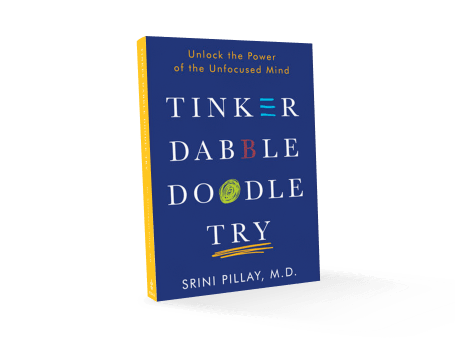MORE FROM DR. SRINI PILLAY
"What leaders need during a crisis is not predefined response plan but behaviors and mindsets that will prevent them from overreacting to yesterday's developments and help them to look ahead." McKinsey & Co., 2020
HIGHLIGHTS

- Develop beyond resilience
- Build a mindset strategy to thrive
- Learn about how you can accelerate leaders and their teams toward success
THE ANTIFRAGILE MINDSET: THRIVE

- VR designed to reduce stress
- Brain-base experiences
- Optimize leaders and teams
VIRTUAL REALITY
I WANT TO HELP YOU UNLEASH
YOUR GREATEST POTENTIAL
Most of us instinctively know we tap only a fraction of our potential. My work uses hard science to unlock “better thinking” for all the possibilities–the growth, the change, the love–that is inherent in you. While studying, working, and teaching at Harvard, I have come to believe there’s an art and science of possibility—that we can be the architects of our own brains. Allow me to show you how.
Collaborate
TINKER DABBLE DOODLE TRY
UNLOCK THE POWER OF THE UNFOCUSED MIND
Tinker Dabble Doodle Try offers a revolutionary way to become a sharper thinker and get things done—in the boardroom, living room, or classroom—by harnessing the brain’s ability to wander.


LIFE UNLOCKED
MOVE PAST THE THINGS THAT LIMIT YOU, AND TRULY UNLOCK YOUR POTENTIAL-AND YOUR LIFE.
Life Unlocked draws from cutting-edge research in human psychology and neuroscience to illuminate the ways in which you can overcome any fear that is inhibiting your movement through life.
FEATURED RESOURCES
Burnout Buster
Dr. Srini Pillay is offering access to the innovative online assessment tool, Burnout Buster. The tool allows you to measure your burnout level, plus identify the top three causes related to…
King T and the Gamma Troupe: The Story of a Brave Bodyguard who Vanquished the Viral Villain
In this story, the brave cell King T battles the evil Vicious V. The next time that a virus hits, you’ll say “don’t mess with me!”It has never been more…
Tinker Dabble Doodle Try
Harness your mind’s innate tendency to wander, stall, rest, and unfocus and become more productive—in the boardroom, living room, or classroom. To finish tasks and achieve goals, most people believe…
The Science Behind The Law of Attraction
“The Law of Attraction” – a law that states that you get in life what you put out – has a dedicated group of followers and dissenters alike. Most people…
Your Brain and Business
Harvard psychiatrist and executive coach Srinivasan S. Pillay illuminates the rapidly-emerging links between modern brain science and the corner office. What does neuroscience have to do with leadership? Everything. In…
Total Brain Makeover
Welcome to one of the most time-efficient programs for achieving major breakthroughs in your life goals. Invest just ten minutes a day and see lifelong impact. How do you formulate…
The Untapped Power of You
With Dr. Pillay as your personal guide, these downloadable audio programs put you on an actionable path toward personal transformation. A great gift to yourself. A potentially life-altering gift to…
Life Unlocked: 7 Revolutionary Lessons to Overcome Fear
Learn simple, effective, easy-to-implement ways to manage fear in your life. Winner of a Books for a Better Life Award Many who find themselves “stuck” in life are vaguely aware…
what people are saying
I have lived with anxiety/panic and OCD for years. I needed help addressing the fear that panic disorder puts into my life....and this book is it!
Kristin
Effective for leaders with a technical background who prefer having scientific evidence to support decisions they make, rather than anecdotal evidence.
James O. via Amazon.com
Dr. Srini Pillay continues to have a major positive influence in my life. Just watching his Ted Talk, "Wired for Success: The Science of Possibility" alone inspired me to make a change. He taught me to connect with my intention and vividly imagine my life and my future to become the hero of my own story.
Teri Cirillo
My go-to expert on fear, grief, and anxiety. Top-of-his-class credentials. A ‘movie-star’ personality who brings a creative spark to every topic.
Michelle Lazcano former Producer Fox 25 News
Dr. Pillay gives us a book that is part owner's manual and part ‘cookbook’ to contemplate change—and improvements in how we use our brain based on current science.

